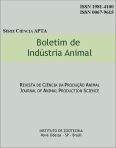Studies on mineral nutrition of five stylo grown in a soil of savanah vegetation of São Paulo State, Brazil. I. Dry matter production, total amount of nitrogen and nodulation
Abstract
This experiment was carried out ai the Estação Experimental Central of the instituto de Zootecnia at Nova Odessa, São Paulo. It was used a Quartzons Sand soil of savanah vegetation and five stylo acessionns (S. humillis S. hamara, S. guyanensis cvs. Schofield, Endeavour and Cook) were studied. Acessions (five) and fertiliation treatments (twelve) were arranged in a factorial design (5 x 12) with three replications. The fertilization treatments consisted of a subtrative assay. It was measured the following parameters: dry matter production, total amount of nitrogen and nodulation. S. guyarnensis cv. Schofield showed the greatest dry matter production and S. humilis responded to the application of more nutrients than the other stylo acessions. Phosphorus was the most limitant nutrient to the normal growth and nodulations of the stylos. Potash had beneficial effects on all variables of Schofield and Cook cultivars and on nodulation of S. humilis, but depressed nodulation of S. hamata. Lime (1.2ton/ha) brought about positive effects on S. humilis and S. guyanensis cvs. Schofield and Cook. The highest lime rate (2.9ton/ha) was negativa to humilis and hamate species. The addition of sulphur favoured the development of S. guyanensis cv. Cook. The single application five micronutrients (B, Cu, Fe, Mc and Zn) resulted in increases on all parameters of S. humilis. Molybderium had positive effects on S. hameta where as iron was deleterious to S. guyanensis cv. Cook.Downloads
Downloads
Published
Issue
Section
License
Os autores não serão remunerados pela publicação de trabalhos, pois devem abrir mão de seus direitos autorais em favor deste periódico. Por outro lado, os autores ficam autorizados a publicar seus artigos, simultaneamente, em repositórios da instituição de sua origem, desde que citada a fonte da publicação original seja Boletim de Indústria Animal. A revista se reserva o direito de efetuar, nos originais, alterações de ordem normativa, ortográfica e gramatical, com vistas a manter o padrão culto da língua e a credibilidade do veículo. Respeitará, no entanto, o estilo de escrever dos autores. Alterações, correções ou sugestões de ordem conceitual serão encaminhadas aos autores, quando necessário. Nesses casos, os artigos, depois de adequados, deverão ser submetidos a nova apreciação. As opiniões emitidas pelos autores dos artigos são de sua exclusiva responsabilidade. Todo o conteúdo deste periódico, exceto onde está identificado, está licenciado sob a Licença Creative Commons Attribution (CC-BY-NC). A condição BY implica que os licenciados podem copiar, distribuir, exibir e executar a obra e fazer trabalhos derivados com base em que só se dão o autor ou licenciante os créditos na forma especificada por estes. A cláusula NC significa que os licenciados podem copiar, distribuir, exibir e executar a obra e fazer trabalhos derivados com base apenas para fins não comerciais.













